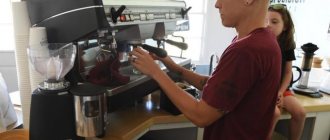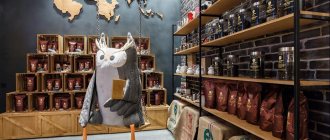History of the profession
The barista profession appeared in Italy with the arrival of automated espresso preparation equipment in Italian bars. The first coffee maker was invented by Luigi Bezzera back in 1901, and since then its design has undergone numerous changes. Technological progress has led to the fact that, along with coffee makers, baristas began to actively use coffee machines, which speeded up and simplified the process of preparing drinks.
On the technical side, it is customary to distinguish between espresso coffee makers and coffee machines. In the first case, using the equipment, you can brew coffee by doing a certain part of the work manually: you need to grind the grain separately, pour the ground powder into the filter of the cone, compact it, forming a coffee “tablet,” and remove the spent grounds from the cone. In the second case, all the work, from grinding to sorting the grounds, is done by the coffee machine. However, the barista in his work uses any equipment that is necessary to obtain the desired result. And besides the equipment, it also has its own individual style, which attracted the owner of Starbucks, Howard Schultz, during his trip to Italy in the 1980s.
Schultz visited several Italian coffee shops, met the baristas, filmed their work, returned to America and began introducing the coffee creation format into his network of establishments. In particular, one of the first standards was the standard for preparing espresso in 17 seconds.
The culture of making coffee “from the master”, coming from Europe, has taken root in Russia, with some changes. The very word “barista” is still perceived as exotic, and even the question of declination (“barista”, “at the barista”, etc.) remains debatable. Representatives of the profession in interviews and news articles most often do not favor him.
Nevertheless, now masters from Russia, participating in the main world barista championship World Barista Championship (WBC), which is held annually, and related tournaments, win victories in various categories. The task of a participant in the WBC qualifying rounds is to prepare 12 different drinks (4 espresso, cappuccino and signature drinks) in 15 minutes. Technical skills in working with grain, a coffee grinder and an espresso machine are assessed, as well as the taste of the resulting drinks. At one of the 1999 championships, Thomas Polti set a kind of record by preparing 680 servings of coffee in an hour using 2 machines.
Differences from a bartender
Despite the fact that each specialist’s workplace is a bar counter, there are differences between them:
| Bartender | Barista |
| Works mainly with alcohol | Prepares espresso and other drinks from coffee beans |
| Deals primarily with chilled beverages | Works with water at elevated temperatures (most often boiling water), which forces you to be careful when brewing coffee |
| No special skills are needed, training is quick and most often on the job | It is necessary to know the culture and technology of preparing different types of drinks. Sometimes it’s worth taking special courses |
Description and characteristics of the profession
Introduction to the profession often begins with an explanation of what the word “barista” means. However, the literal translation from Italian - bartender, a person working behind the bar - does not entirely accurately reflect the modern understanding of the functions of a specialist.
Nowadays in Russia this word is most often used to describe coffee masters in cafes who specialize exclusively in coffee drinks and their serving. In European and, in particular, Italian traditions, the meaning of the word expands. There, this term can refer to both the owner of a coffee shop and the bartender who prepares both coffee and alcoholic cocktails. Sometimes a barista combines several functions. In Russia, a job description may also oblige a barista to serve coffee and wash cups as an employee. Therefore, it is more correct to look for the difference in the scope of concepts not in the set of functions “there” and “here”, but in the philosophy and method of forming an idea.
Howard Schultz, distributing the Italian format in his network of coffee shops, was fascinated not just by the fact of making coffee. He was captivated by the style of creating the coffee drink, the artistry and atmosphere of the establishment. To see who a barista in a cafe is, from Schultz’s point of view, you need to imagine a charismatic alchemist who, in his laboratory, by strictly following the recipe, creates a special composition, while the action itself looks like witchcraft. Such a person knows everything about coffee and can reveal the secrets of selecting beans, methods of drying, storing, roasting, and grinding. Making coffee becomes a way of self-expression for him.
In a more prosaic sense, the position of a barista comes down to knowing the recipes for about 40 coffee-based drinks and the ability to prepare them using a coffee machine and other professional equipment.
Ideally, this specialist should know everything about coffee and the process of its preparation, take into account the tastes of visitors and advise the variety or blend that best meets the client’s needs.
In practice, when hiring, exhaustive knowledge may not be necessary. However, a professional barista, in any case, must be fluent in operating a coffee maker, coffee machine, pitcher (special container for milk), grinder (professional coffee grinder) and other devices, understand the principle of their operation, know the terminology and have an understanding of the varieties and types of grain, the influence of grinding, roasting and water temperature on the taste of the product.
Descriptor
The word descriptor (“describing”) is Latin. However, it came into our professional language from English, along with other coffee terms. This is a unit of description of the taste and aroma of coffee. With the help of descriptors, we divide the complex taste of a drink into its components and tell what it tastes like. For example, coffee from Brazil may have the descriptors “dark chocolate, roasted hazelnuts, caramel,” and we will describe coffee from Kenya with the words “raspberry, black currant, apple.”
Descriptors can tell you how one coffee differs from another and what spectrum of flavors you can taste. Such descriptions are found on coffee packs, and baristas also use them when talking about the taste of their drinks.
Directions, specialties and educational institutions according to the profile of training
There is no separate established specialty for the barista profession yet. But basic education, which will be useful in work, can be obtained by studying to become a bartender in the specialization “waiter, bartender” (code: 5.43.01.01) and related areas: “service organization in public catering” (code: 5.43.02.01), “ technology of public catering products" (code: 2.19.02.10).
Coffee and restaurant establishments, especially chain ones, often organize training courses themselves or hire professionals to conduct master classes and trainings.
Among the most famous educational institutions in Russia
- “Barista School” from the North-Western Coffee Company (St. Petersburg),
- “Institute of Coffee and Tea” (permanent courses are conducted by a St. Petersburg consulting company),
- Academy of Coffee Art (this is another St. Petersburg company that builds training on the basis of the “Viennese coffee culture”, the founder of which was Julius Meinl),
- training center of the Siberian Hospitality Association (Krasnoyarsk).
You can also become a barista through courses at the St. Petersburg Bartenders Association, the Russian branch of SCAE.
The basics of this profession are provided by Vocational Lyceum No. 11, Resource Center of the Siberian Vocational Lyceum No. 18, Baltic Institute of Tourism, St. Petersburg College of Economics and Technology, etc.
Abroad, training in most cases takes place under the auspices of the European (SCAE) and American (SCAA - Specialty Coffee Association of America) associations. Among the most famous training centers are
- Coffee Society of Great Britain,
- London Coffee School
- Berlin coffee school
- Spanish Coffee Institute,
- School "9 bar" (Italy),
- American Barista and Coffee School,
- Canadian Barista and Coffee Academy,
- Barista Education Specialty Training "BEST" (USA),
- JP's Coffee & Espresso Bar (USA), etc.
Prices
You can buy Barista brand products in specialized coffee shops, online platforms or large chain markets. The cost varies; it is better to avoid suspiciously inexpensive offers, since branded goods are often counterfeited.
On average, a barista will have to pay 500 rubles for a pack of 250 g of bean or ground coffee. You can find offers starting from 300 rubles. The grain product costs about 1,500 rubles. per pack weighing 1000 g.
Professional Responsibilities
To learn more about a barista and understand who he is, you need to familiarize yourself with the list of his main and optional responsibilities.
- Ability to create various drink options (about 40 types) using all barista tools. To do this, the master must know how to change the degree of grinding, increase or decrease the pressure in the machine, regulate the amount of coffee in a serving, vary the strength when tempering (tamping) a coffee “tablet,” use a steam nozzle to heat and froth milk, etc.
- Knowledge of varieties, types and types of coffee beans, the dependence of taste on the place and time of harvest, degree of roasting, grinding and other physical characteristics.
- The ability to understand the quality of prepared coffee by taste, smell, color, consistency.
- Skills in preparing and using milk and milk foam, proficiency in the art of latte art - methods of pouring prepared milk with the formation of patterns and refinement of drawings in different styles.
- The desire and ability to interact with visitors, remember their tastes and preferences, and, if necessary, add show elements to the work.
In general, a professional is required to have everything that is needed to prepare the drink in different versions, as well as the ability to arrange and serve coffee to a visitor to a cafe or restaurant.
Hello my dear comrade!
You are looking for a job and want to become a real cool barista.
The idea is great - this is a very interesting profession that is fraught with real romance, but it is worth remembering that working as a barista is quite difficult. Working as a barista is a full-time profession that requires both mechanical skills and knowledge in the field of coffee, geography, a little physics and chemistry. But the most difficult thing about being a great barista is the ability to communicate with people. Sometimes your salary will directly depend on this skill. Just don’t say work as a barista, this word is not inclined in Russian =)
Who is it suitable for?
Focusing on the duties of a barista, we can say that this job is primarily suitable for enthusiastic and sociable people. The aesthetic component when designing a drink is also important, because it is easier to win the love of the public and attract its attention, since the original design will be appreciated by more people than specific shades of taste, the perception of which requires both preparation and sensitivity of the receptors. Therefore, people with artistic abilities will also find it easier to find themselves in the profession.
This work has no fundamental restrictions on age and gender, but traditionally, in the West, baristas are often middle-aged men, and in Russia, young men and women under 25 years old.
Working conditions
Working hours are divided into twelve-hour shifts with a schedule of two days after two or three days after three.
According to sanitary standards, all catering staff must have a health certificate. This rule also applies to baristas. Its registration costs up to 5 thousand rubles.
The work can be done either with a partner or independently. Management constantly monitors work and can arrange an inspection at any time. For violation of discipline, prescription, or appearance, a fine may be imposed.
During lunch breaks you are allowed to drink a cup of coffee, and in some establishments, eat a sandwich.
Barista salary
On the market, a barista vacancy is estimated at 35-65 thousand rubles per month in Moscow. In the regions - from 20 thousand rubles. But employers are willing to pay more to a specialist with a name who has gained popularity and is able to attract clients.
Tips are often added to the salary amount, but their amount largely depends on the place of work. Even if we compare the wages of Western baristas, the average tip size will greatly depend on the country and even the city. A study of barista pay around the world showed that Australian baristas earn the most (more than $44/hour), while English baristas earn relatively little, even taking into account tips.
General recommendations for filling out a resume
A resume should contain personal data, information about work experience, education, skills - everything that is necessary to form a professional portrait of a candidate for the position. Describe why you want to work in this particular establishment, what you plan to achieve, and what will change in the coffee shop with your arrival.
When filling out blocks, use short, informative phrases.
Enter the name of the position you are applying for. If you can perform the duties of a barista, waiter or bartender, draw up three different documents. Set your desired salary to be 10-15% higher than the average in the region or slightly more than the salary at your last place of work.
Check the form for typos and grammatical errors.
The barista is the first person a visitor sees when opening the door of a coffee shop. Every establishment owner wants customers to be served by a friendly, good-looking person. Having a business-style photograph on your resume will speed up the decision-making process.
Prospects for the profession
People are gradually getting used to spending their leisure time outside the home, having breakfast and meeting friends in public catering chains, so the need for professional baristas will only grow over time. Preference will be given to masters who have managed to develop an individual style and master impeccable basic coffee-making techniques combined with a special, unique flavor.
If you still have the slightest doubt that the barista profession is right for you, then we strongly recommend taking a career guidance test from Profgid . It costs mere pennies, and at the same time allows you to avoid mistakes that can go in the wrong direction and cripple your entire life. Find out more >>
Contact Information
To contact the applicant, the employer will need a current mobile phone number and email address. It is advisable to indicate information about accounts if there is information about professional activities. For example, you write a blog about coffee or regularly post photos of the drinks you prepare on Instagram.
For addresses and profiles, use last name or job title.
CONTACTS
- Telephone:
+7 - Email:
- Skype:
Barista_myresume
- Instagram:
@Sokolova_myresume











